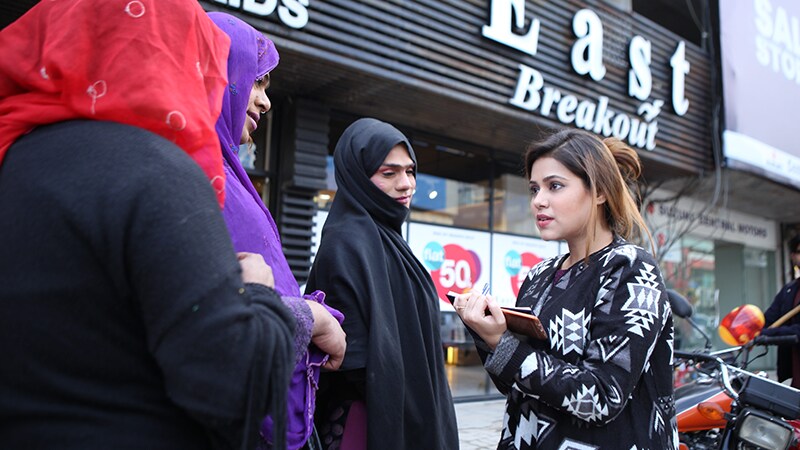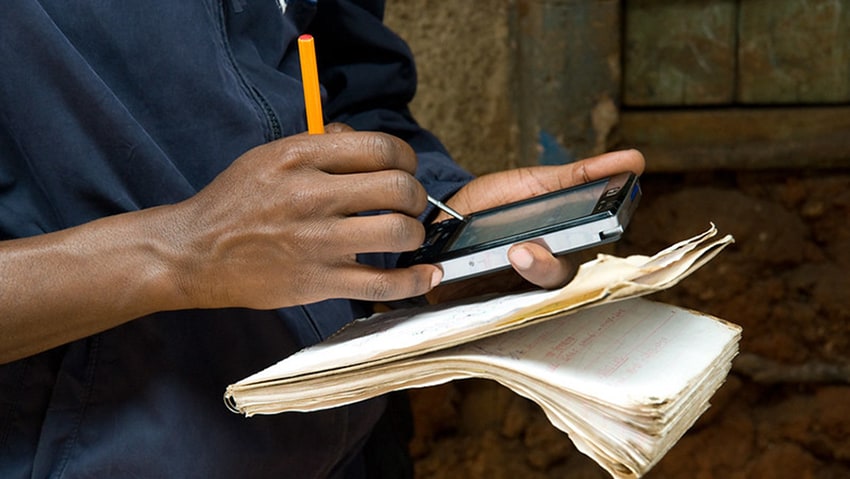Guiding Principles for Visual Products

- Diverse representation: Do the featured people authentically represent the diverse sub-populations within the population of focus? Are people or cultures represented in a monolithic, stereotypic manner? Are the visuals for global programs adapted to represent local populations and cultures where program implementation occurs? Are the visuals respectful to people with disabilities and reflect the variety of diverse abilities? Do the visuals portray or promote gender diversity/balance instead of gender stereotypes?
- Individual dignity and respect: Were the visual products ethically sourced ? Are the people in the visual product portrayed with dignity and as human beings with unique experiences? Have the people in pictures and videos consented to the use of the product?
- Cultural respect: Does the visual product evoke cultural appropriation, such as borrowing a group’s cultural symbol and using it incorrectly or in a way that does not respect or honor the group’s culture? Are there any hurtful or insensitive historical connotations inherent to the visual product?
- Inherent power and capacity: Are harmful power dynamics depicted? How can you show that the local community has the power and capacity to address public health issues within their community? Are the local organizations, materials, doctors, teachers, community health workers, volunteers, leaders, researchers, scientists, or problem solvers represented? Is equity between different people/groups portrayed?
- Emotion: Which emotions are triggered by the visual product and to what purpose?
- Problem or solution: Does the visual product show only the problem or does it also show the solution/opportunity/current efforts and the people working toward future solutions?
- Connection to reality: To what extent do the visual products depict the reality of the situation? What is the context/story and is it clearly communicated? Who are the people in the graphic and how do they relate to the situation? Are people shown engaging in common day-to-day activities (e.g., buying groceries) or are they only shown in a historical/traditional sense (e.g., traditional dress that is worn on rare occasions)?
- Original purpose and intended use: Especially for previously published visual products, to what extent are the planned uses consistent with the original purpose/message of the product?
- Graphic and text: In what ways do the text and visual product complement each other? Does the visual product show anything that is not representative of what is discussed in the text? Even if the visual product passes all of the above questions, does the text?
- Conceptualization: Before arrangements are made to capture a photo or video, consider the ethical dynamics of the proposed shoot. Consider whether taking photographs/videos is even acceptable within a given community/country and whether any kind of imagery is culturally unacceptable (e.g., not taking photos of art or religious objects). Determine whether the photo/videographer is familiar with the local context/culture and whether it is possible to hire local photo/videographers. Consider the legal context and whether the participant’s safety could be put in danger (e.g., LGBTQI+ persons in countries where some gender and sexual identities and behaviors are criminalized). Ensure you have a method for obtaining informed consent.
- Cultural context: Consider the cultural expectations of privacy and photo/videography. If you are not from a culture or do not have deep knowledge of a culture you want to feature, it is important to educate yourself about subcultures within a group and work with knowledgeable partners (e.g., community members, intermediaries familiar with the culture, anthropologists, etc.) to accurately depict cultures and subcultures. Ensure that any imagery used in reports and publications will be acceptable to the government, ministry of health, or partner agency/organization in question.
- Power dynamics: Consider the power dynamics of who is behind the camera in relation to who is in front of the camera (e.g., socioeconomic status, citizenship, profession, agency, gender, religion, political affiliation, health status, education, etc.) and how you can mitigate any power imbalances. Work with the participant to identify how they would like to be represented and how to respect the participant’s dignity. Avoid unintentional coercion and ensure there is always an opportunity to opt-out of participation.
- If a participant from the population of focus wishes to opt-out at any point during the process (beginning, middle, end, or after publication), respect their wishes to disengage and permanently delete any images/footage already captured.

An epidemiologist conducts contact tracing in Pakistan in 2018. Photo provided by Eisha Mansoor/FELTP Pakistan
Production Phase
- Interaction with subjects: If it is not possible to hire a local photo/videographer, consider whether an interpreter is required and whether the participant(s) is familiar with the agency you represent and its global public health work. Practice cultural humility, be mindful of potential power dynamics, and be flexible according to the participant’s preferences.
- Informed Consent is permission that a person grants to the photo/videographer, with full knowledge of where, how, and for what purpose the photographs/videos will be used, and with the understanding that they can stipulate conditions and decline consent without consequence. The consent process should occur in a low-pressure manner, in which the persons featured have the ability, opportunity, and power to make an informed decision.
- Request consent before taking a photo/video and collect proof of consent using the methods approved by your organization. Parental consent must be provided for participants who are under 18 years old.
- Since it is impossible to control the spread of an image or video once it is published online, explain that other people/organizations can take published images from your agency’s sites and use it for their own purposes.
- Translate consent forms. For languages without a translated form, verbally translate the consent form for the participant. Also read aloud/translate forms for anyone with low levels of literacy.
- Commitments: After discussing with the participant how they would like to be represented, only capture photos/videos that honor that request. Ensure the subject knows and agrees to how the final product will be used.
- Capturing the photo/video:
- Angle. Consider the following angles and what they may convey to a viewer.
- High angle (captured from above): Participants may appear weak, inferior, and helpless.
- Eye-level: When the lens of the camera is eye-level with the participant, the final product shows the least amount of inferiority or superiority.
- Low angle (captured from below): Participants may appear powerful, dignified, or strong.
- Angle. Consider the following angles and what they may convey to a viewer.
- Activity of the subject. Work with participants of all abilities to identify their preferred level of activity in the image/video. In general, images/videos of people in action/motion can convey agency and vitality. Even if the participant is lying in a hospital bed, human interaction with a doctor or visitor can help convey dignity, humanity, and compassion.
- Anonymity. Ask if the participant wants their face to be shown. If someone requests that their face not be shown, it is possible to capture quality photos/videos that still protect their identity. This is especially important in healthcare settings. Try the following:
- Photograph/video someone from behind.
- Fill the frame with the person’s hands.
- Take pictures/videos of personal effects or other physical items instead of the person. However, do not include items with personally identifiable information (e.g., license plates, passports, IDs).

CDC partners with local agencies in Kenya to provide new technology to assist in disease surveillance. Photo by David Snyder/CDC Foundation
Selection Phase
- Dignity: Even with informed consent, carefully select final products that depict the subject in the most dignified way.
- Representation: Only select and publish final products that accurately depict the scene/individual(s). Avoid capturing and publishing photos/videos that reinforce stereotypes/typecasting.
- When choosing a photo from repositories, ensure that the caption aligns with the nature of the product.
- Sharing: Share the final product, with participants prior to publication. Also request feedback and accept objections prior to publication. If a participant takes issue with the final product, work with them to identify the preferred course of action (e.g., different photo/video, additional/less editing, pull from publication altogether).
Publication Phase
- Captioning: Each photo/video should be accompanied by a caption that accurately describes who and what is featured. Videos should be accompanied with closed captioning of what is being said in the video to be fully accessible for those with hearing disabilities. When possible and needed, include a sign language interpreter in the video as well as in-person interactions.
- Alternative Text/Audio Descriptions: Provide alternative text for each photo/graphic and audio descriptions within videos to be fully accessible for those with visual disabilities.
- Subtitles: If subtitles are necessary, ensure the translation is accurate and conveys the speaker’s intended meaning.
- Metadata: Once the final product is published online, there is very little a photo/videographer can do to control who sees it or how it is used. The best measure of due diligence is to embed the photo/video with complete metadata, which includes a caption, credit, point of contact, and organizational affiliation.
- Responsible use: Even when informed consent is obtained, global public health agencies must still be considerate of how photos/videos are used. Even if a person signed a general photo/video release form, they are not necessarily agreeing to be the face of a campaign or resource that could unintentionally provoke stigma within their communities. For example, a photo of a woman in her home should not be used for a campaign about domestic abuse or HIV/AIDS unless she explicitly agreed to her photograph being used for this purpose.
- When choosing a product from repositories, credit/attribute the product to the original artist within your final product.

Do you have questions or feedback?
Please contact us at cdcglobal@cdc.gov